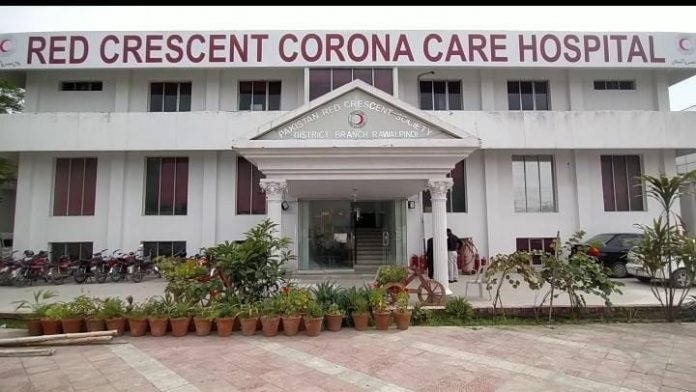Khalid Bin Majeed
The killer coronavirus disease COVID-19 spilled over to Pakistan in February. It soon took root and began to course through the length and breadth of Pakistan, taking its toll on more and more people.
With the outbreak of the epidemic, the federal government together with the provincial governments, the armed forces and the international community and human rights organizations has moved heaven and earth to stem its tide, minimize infections and deaths, cushion maximum number of people against poverty, hunger, and starvation [by doling out monetary assistance] and save the private sector employees from mass layoffs by offering cheaper loans to their employers.
Like the other state institutions, the Pakistan Red Crescent Society – undoubtedly the major humanitarian organization in Pakistan affiliated with 192 National Societies – too decided to contribute to the government’s anti-corona efforts, as no government could come to grips with such challenges of magnanimous proportions single-handed.
As the top brains sat across the table in the committee room to brainstorm and map a slew of initiatives, Chairman Abrar Ul Haq spoke up, “Let us contribute in a big way starting off with a hospital to treat the corona patients and send them back home with a clean bill of health.” His idea raised many an eyebrow, as it seemed impracticable given the large sums of money involved.
Arguments against the project outweighed those in favor [of the idea], but Mr. Haq stuck to his guns. Like a leader who knows the way, goes the way, and shows the way, Mr. Haq unbundled his plan. After delineating it, looking at me saddled next to him, Mr. Haq said, “This is a challenge and I leave it to you and your team how to go about it.” Drawing strength from the never-say-die determination writ large on the face of our worthy chairman, I said, “Consider it done, sir!”
As per the plan, funding was immediately arranged from own resources and through the IFRC. The Executive Committee Members played a very supportive role by providing guidance, and ensuring prompt approvals and decision-making.
It was due to these combined efforts, that the old building of the PRCS branch in Rawalpindi got a massive facelift and metamorphosed into a state-of-the-art corona care hospital within record 18 days. Like a close-knit family, almost everyone at the PRCS down to the watchman chipped in – directly or indirectly – to transform the chairman’s dream into a reality.
Standing majestically at a stone’s throw from the famous Siddiqui Chowk, the stately hospital – a testament to the monumental efforts and dedication of the PRCS team – is now abuzz with a feverish human activity centered round treating the corona patients and taking best care of them. Around 74 patients have been treated and sent back home, while 20 patients are under treatment.
In spite of the fact that Prime Minister Imran Khan is deeply engaged on many domestic and international fronts, he took time out and visited the hospital. Chairman Abrar Ul Haq gave the prime minister a detailed briefing after he had visited round all the sections of the hospital.
With a beaming face and undisguised glee, the prime minister appreciated the chairman and the entire PRCS team for the project and expressed hope that it would go a long way towards addressing the health challenge in a surefire way.
The three-floor hospital has a 44-member staff headed by Deputy Medical Superintendent Dr Saim Bin Saeed. The hospital, equipped with nine ventilators and other facilities, has been set up in accordance with the recommendations of the Chinese health experts. It has two buffer zones, male and female isolation wards and an intensive care unit (ICU).
An exclusive fever clinic has also been set up at the hospital in accordance with the ‘three-zones-two-passages’ strategy adopted by the Chinese health experts at their hospitals to control the flow of citizens.
Under this strategy, one zone has been demarcated for the contaminated people, one for potentially contaminated people, and one for non-infected or non-contaminated people. Each of these zones is separated by two buffer zones many feet apart. A fourth passage has been dedicated for contaminated medical items and other articles whose movements are strictly monitored.
It merits a mention that the Chinese health professionals also visited the hospital, reviewed all the arrangements in the light of their own experiences in their homeland, and gave their useful suggestions and recommendations.
Here I would be doing a huge injustice if I do not mention the contribution of Deputy Commissioner Rawalpindi Captain (retired) Izhar Ul Haq and Vice Chancellor Rawalpindi Medical University (RMU) Dr Muhammad Umar to the hospital project. They went out of their way to support this ambitious project and ensured their availability round the clock. They are a valuable asset that we need to protect, perhaps a little better than we normally do.
The hospital is a capital-intensive project needing a steady, uninterrupted flow of monetary assistance in the pipeline to stay on the tracks. The funding must not choke come hell or high water. Pounds, pennies, dimes, and shillings must keep pouring in to keep the bucket full. We have to keep in mind that drop-by-drop a bucket gets filled [to the brim].
Last but not the least: the Pakistan Red Crescent Society owes its gratitude to all those who wholesomely contributed to the project. This continuing charity will stand them in good stead in this world and the hereafter. – The writer is Secretary General Pakistan Red Crescent Society

















